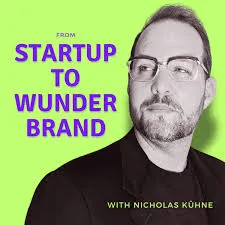
Clear steps for coaches and freelancers: niche with three layers, productise services, and price by outcomes — practical advice from Robin Waite.
In a recent episode of From Startup to Wunderbrand, host Nicholas Kuhne talks to Robin Waite, founder of Fearless Business and author of Take Your Shot, about the practical nuts and bolts of turning a small coaching or freelance business into a scalable, profitable offer. Robin walks through why clarity (who you serve and how), productisation, and value-based pricing beat “shouty” social posting and hourly billing every time, plus how identity and tribe shape the customers you attract.
Nicholas Kuhne, host of From Startup to Wunderbrand, is the founder of the brand consultancy Wunderbrand and a lecturer at Noroff University College in Norway. With over two decades of experience across Africa, Europe and Asia, Nicholas has developed a distinctive approach to guiding multinational businesses through complex and often challenging environments. His career highlights include launching Comedy Central in Africa as head of marketing at MTV, serving as Managing Director of Interbrand in West Africa, and shaping marketing for sectors as diverse as telecoms, banking, and public health. Having started his journey at the iconic Nando’s brand, Nicholas brings both creative flair and strategic insight to his work, making him a trusted voice on brand building in global markets.
Robin frames the problem as three big shifts: vastly more businesses, fast global internet access and the rise of social media. These make starting a business easier but marketing harder — you’re competing with far more people and a global marketplace that rewards strategic reach, not volume of noise.
Common mistakes he sees:
Industry, role, age bracket, geographic region. Useful for segmentation but insufficient on their own.
What podcasts do they listen to? Which Facebook groups, newsletters or conferences do they attend? This layer tells you where to place your content so it’s seen by the right people.
Values, adventurousness, risk profile, lifestyle. Identity creates tribes. Show your personality (Robin’s “fearless” vibe: surfing, cycling, the slightly edgy tone) and you’ll attract clients who resonate, not everyone will, and that’s fine.
Most creators assume people will figure out what to do next. They won’t. Robin recommends mapping a simple, friction-free funnel:
Make each step obvious and repeatable, your content’s job is to move people one notch closer to a sale, not to do the sales job itself.
Turning bespoke work into a systemised product means:
Example: a dog-groomer who wants $10,000/month can rework a $50 single groom into a $125 packaged experience with upsells and membership options, reducing capacity pressure and improving referrals.
Robin gives three web designer archetypes to illustrate pricing logic:
Principles to price by:
Robin stresses: don’t try to be a clone of competitors. Showing your real identity attracts the right people and repels the rest, which is good. Playing a role you don’t enjoy (for ego or perceived professional image) makes consistent marketing impossible. Choose authenticity over “generic professional” every time.
Robin posts videos on YouTube and has signed copies of Take Your Shot available at fearless.is/t ys (Robin’s special signings and shipping notes were mentioned in the episode). For entrepreneurs stuck in the trap of “busy but not profitable,” start by mapping your customer journey and testing a productised offer with a clear outcome.
The episode is a crisp reminder that marketing isn’t about shouting louder — it’s about being clearer. Clarity in who you serve, how you reach them and the unique identity you bring will always beat frantic activity. Productise your work, price on value not time, and build funnels where each piece of content has one simple, obvious next step. Do those things and you stop trading hours for income and start building a business that scales.
Answer 40 questions and we’ll send you a personalised report with feedback tailored to your specific needs. It's quick and free and you get a FREE copy of Take Your Shot.
This Scorecard has been designed to show Coaches, Consultants and Freelancers their blind spots and provide instant, actionable steps on how to increase their prices.
